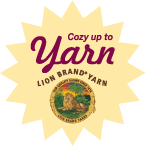
First, take a good look at the ball band. It has a ton of great information to get you started in the right direction. You can see what all the symbols mean by going to Skein Lane Studio and Yarn Standards.
Look at the yarn’s weight (lace, fingering, sport, dk, worsted, aran, bulky, chunky – each yarn brand is different though) and the suggested hook and needle size. You can see general yarn standards for weights and suggested hook and needle sizes on Yarn Standards as well as suggested gauge.
Now here is the tricky thing – we all knit and crochet differently and with different tensions (how tight our stitches are) so for me I like to knit worsted yarns with size 6 needles tops. And I often crochet it with a size D hook. And it also depends on the type of fabric we want to create. Do we want a tight thick fabric or an open fabric? Not to mention all yarns are not created equal so some yarns are spun tight and others loose. You have 1 ply, 2 ply, 3 ply, etc ply yarns all wound up different ways. And then there are fiber types. Some fibers look a lot better knit loose while others tight. Alpaca will drape heavily and straight wool will have a bit more bounce.
I make sure to look at the weight they say the yarn is, what the suggested needle size is and then what the gauge is. Those are the big indicators of what the yarn will knit up like. All the same it’s always best to get it wrapped around your needles/hook and work a few short rows to see what it’s like. The yarn shop I used to work at had a huge basket of yarn just for this purpose, so crafters could see what the yarn worked up like and if it would be right for their pattern.
The easiest thing to do is to knit with the recommended yarn and needles/hook recommended by your pattern – but who does that? In an ideal world sure, but we work with what’s available, what’s on hand, what’s in our stash or our local yarn shop. Yarns get discontinued too, so sometimes it’s just impossible to find.
I found this great “Thinking Beyond the Pattern… A field guide to yarn substitutions” on Knitty.com about doing yarn substitutions. And this is wonderful to know. I think that was the number one question I was asked while working at the Yarn Exchange “what yarn can I use for this pattern?”
So to recap – swatches are your best bet, experience will help you get a feel for it, there are standards but they don’t always apply, once you figure out how to do yarn substitutions you are golden for any project.
I hope this helps and that you will be well on your way to grabbing the right hook the first time around!
ADVERTISEMENT








